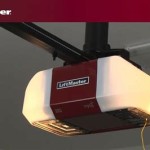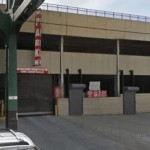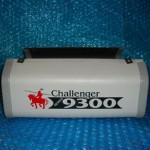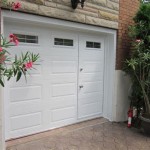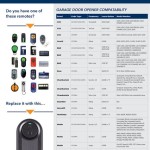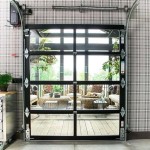Garage Door Falling Off Track: Causes, Prevention, and Solutions
A garage door that has come off its track is a significant problem that can compromise the security of a home, impede access, and pose a safety hazard. Understanding the reasons behind this malfunction, implementing preventative measures, and knowing the steps to take when it occurs are crucial for homeowners.
The proper functioning of a garage door relies on a delicate balance of components working in harmony. The door rollers must remain securely within the tracks, allowing the door to move smoothly up and down. When this alignment is disrupted, the door can become misaligned and eventually detach from the track altogether. Ignoring this issue can lead to further damage to the door, the opener, and even surrounding structures.
Common Causes of Garage Door Track Derailment
Several factors can contribute to a garage door falling off its track. Identifying these causes is the first step in preventing future occurrences.
Damaged or Worn Rollers: Garage door rollers are responsible for guiding the door along the track. Over time, these rollers can become worn, cracked, or even break. This degradation can prevent the rollers from moving smoothly, causing them to bind and potentially jump the track. Rollers constructed from nylon or plastic are typically more prone to wear than steel rollers. Regular inspection and replacement of worn rollers are essential for maintaining proper door operation.
Bent or Misaligned Tracks: The tracks themselves can become bent or misaligned due to impacts, settling of the foundation, or even gradual wear and tear. A bent track creates an uneven surface, making it difficult for the rollers to navigate. A misaligned track throws off the entire balance of the door, increasing the likelihood of derailment. The severity of the bend or misalignment will directly affect the smoothness of the door's operation. Even a slight deviation can cause problems over time.
Loose or Missing Hardware: The hardware that secures the tracks to the garage walls and the rollers to the door panels is critical to the system's structural integrity. Loose screws, bolts, or brackets can allow the tracks to shift or the rollers to become detached. Over time, vibrations from the door's operation can loosen these fasteners, making regular tightening essential. Missing hardware requires immediate replacement to ensure the door remains securely attached to the tracks.
Obstructions and Impacts: Accidental impacts from vehicles or stored items coming into contact with the garage door can cause significant damage, leading to track misalignment or roller displacement. Even seemingly minor collisions can compromise the structural integrity of the tracks and rollers. Similarly, obstructions in the track, such as debris or ice buildup, can impede the rollers' movement and force them off course. Regular clearing of the track area is vital to prevent such incidents.
Broken Cables or Springs: While not directly related to the tracks themselves, a broken cable or spring can place undue stress on the remaining components, including the tracks and rollers. When a spring breaks, the door's weight is no longer properly balanced, which can cause the door to jerk or bind, potentially dislodging the rollers from the track. Damaged cables can have a similar effect, as they are responsible for lifting and lowering the door evenly. Replacing broken springs or cables promptly is crucial to prevent further damage to the entire system.
Improper Installation: A poorly installed garage door system is inherently more susceptible to problems, including track misalignment and derailment. If the tracks were not properly aligned during installation, the rollers will be forced to operate under stress, increasing the likelihood of them jumping the track. Inadequate support for the tracks can also cause them to shift over time. Choosing a qualified and experienced installer is paramount to ensuring the long-term reliability of the garage door system.
Preventative Measures to Minimize the Risk of Derailment
Implementing a proactive maintenance schedule can significantly reduce the chances of a garage door falling off its track.
Regular Visual Inspections: Conduct regular visual inspections of the garage door system, paying close attention to the tracks, rollers, and hardware. Look for signs of damage, wear, or misalignment. Check for loose screws, bolts, and brackets. Observe the door's movement as it opens and closes, noting any unusual noises, jerking motions, or unevenness. Addressing these issues early can prevent them from escalating into more serious problems.
Lubrication: Lubricate the moving parts of the garage door system regularly, including the rollers, hinges, and springs. Use a silicone-based lubricant specifically designed for garage doors. Avoid using oil-based lubricants, as they can attract dirt and debris, which can accelerate wear and tear. Lubrication helps to reduce friction, ensuring smooth and quiet operation and extending the lifespan of the components.
Track Alignment and Cleaning: Periodically check the alignment of the tracks and ensure they are securely fastened to the garage walls. Use a level to verify that the tracks are plumb and aligned with each other. Tighten any loose hardware and clean the tracks to remove any debris or obstructions. A clean and well-aligned track provides a smooth and unobstructed pathway for the rollers.
Roller Replacement: Replace worn or damaged rollers promptly. Do not wait until the rollers completely fail, as this can cause further damage to the tracks and other components. Steel rollers are generally more durable than nylon or plastic rollers, but they may require more frequent lubrication. Regardless of the material, rollers should be replaced every few years, or sooner if signs of wear are evident.
Spring Maintenance: Garage door springs are under high tension and can be dangerous to work with. It is recommended that spring maintenance, including adjusting or replacing springs, be performed by a qualified professional. However, homeowners can visually inspect the springs for signs of damage, such as cracks or rust. Any concerns about the springs should be addressed by a professional immediately.
Professional Servicing: Schedule regular professional servicing of the garage door system. A qualified technician can perform a thorough inspection, identify potential problems, and make necessary repairs or adjustments. Professional servicing can help to ensure the long-term reliability and safety of the garage door system. Annual servicing is generally recommended, but more frequent servicing may be necessary for older or heavily used doors.
Steps to Take When a Garage Door Falls Off Track
If a garage door comes off its track, it is important to take immediate action to prevent further damage and ensure safety.
Do Not Attempt to Operate the Door: Do not attempt to open or close the garage door using the opener. This can cause further damage to the door, the opener, and the surrounding structures. The opener is designed to operate a door that is properly aligned and balanced. Attempting to force the door open or closed when it is off track can put undue stress on the opener and potentially damage it beyond repair.
Assess the Situation: Carefully assess the situation to determine the extent of the damage and the cause of the derailment. Look for any obvious signs of damage, such as bent tracks, broken rollers, or loose hardware. Note the position of the door and any potential hazards. Documenting the situation with photographs can be helpful when contacting a repair professional.
Disconnect the Opener: Disconnect the garage door opener from the power supply. This will prevent accidental operation of the door while repairs are being made. Locate the emergency release cord, which is typically a red handle hanging from the opener. Pull the cord to disengage the opener from the door. This will allow the door to be manually operated, but only attempt to do so if it is safe and the door is not in danger of falling.
Secure the Door: If possible, secure the door in place to prevent it from falling. Use clamps, blocks of wood, or other supports to hold the door in position. Be extremely careful when working around the door, as it can be heavy and unstable. Safety should be the top priority at all times.
Contact a Qualified Repair Professional: It is strongly recommended that a qualified repair professional be contacted to repair a garage door that has come off its track. Garage doors are complex systems with numerous components that can be dangerous to work with. A professional has the knowledge, experience, and tools necessary to safely and effectively repair the door. Attempting to repair the door yourself can result in serious injury or further damage.
Provide Information to the Repair Professional: When contacting a repair professional, provide them with as much information as possible about the situation, including the extent of the damage, the suspected cause of the derailment, and any other relevant details. This will help the professional to diagnose the problem and determine the appropriate course of action.
Addressing a garage door that has fallen off its track requires a careful approach that prioritizes safety. By understanding the common causes, implementing preventative measures, and knowing the steps to take when it occurs, homeowners can minimize the risk of derailment and ensure the long-term reliability of their garage door systems. Regular maintenance and prompt attention to any signs of trouble are essential for maintaining a safe and functional garage door.

Quick Fixes To An Off Track Garage Door Spectrum Overhead

How To Fix A Garage Door That Has Gone Off Its Track

Fix Garage Door Roller Popped Out Youtube

Car Crashes Garage Door Off Track Emergency Closure

Garage Door Off Track All You Need To Know

Garage Doors Off Track Columbia Md Horizon

Off Track Garage Door Repairs Phoenix Southwest Doors

Off Track 3rrr Garage Door And Gates Repair

How To Fix Garage Wheel Off Track

Garage Door Off Track Repair Fall River
See Also

